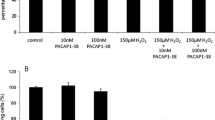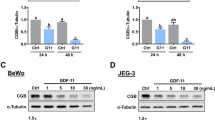Abstract
Pituitary adenylate cyclase-activating polypeptide (PACAP), a neuropeptide with survival-promoting actions, has been observed in endocrine organs and is thought to play a role in reproductive functions, including pregnancy. PACAP occurs in two forms, 27 and 38 amino acid residues, with PACAP38 being the predominant form in human tissues. In the present study, we determined the concentrations of PACAP38 and PACAP27 in first-trimester and full-term human placentas using radioimmunoassay. We found high levels of PACAP38 and lower levels of PACAP27 in different parts of the full-term human placenta. PACAP38 content increased in the placenta during pregnancy, both on the maternal side and on the fetal side. The effects of PACAP on the survival of JAR human choriocarcinoma cells were investigated using flow cytometry and MTT (3-(4,5-dimethylthiazol-2-yl)-2,5-diphenyl tetrazolium bromide) cell viability assay in cells exposed to the widely used chemotherapeutic agent methotrexate (MTX). It was found that PACAP neither influenced the survival of JAR cytotrophoblast cells nor affected cellular response to the death-inducing effect of the chemotherapeutic agent MTX. The present observations further support the significance of PACAP in the human placenta. The observation that PACAP did not influence the effects of MTX may have future clinical importance, showing that PACAP does not decrease the effects of certain chemotherapeutic agents.






Similar content being viewed by others
References
Arimura A, Somogyvari-Vigh A, Miyata A, Mizuno K, Coy DH, Kitada C (1991) Tissue distribution of PACAP as determined by RIA: highly abundant in the rat brain and testes. Endocrinology 129:2787–2789
Aubert N, Vaudry D, Falluel-Morel A et al (2008) PACAP prevents toxicity induced by cisplatin in rat and primate neurons but not in proliferating ovary cells: involvement of the mitochondrial apoptotic pathway. Neurobiol Dis 32:66–80
Boronkai A, Brubel R, Racz B et al (2009) Effects of pituitary adenylate cyclase activating polypeptide (PACAP) on the survival and signal transduction pathways in human choriocarcinoma cells. Ann NY Acad Sci 1163:353–357
Castorina A, Tiralongo A, Giounta S, Carnazza ML, Rasi G, D’Agata V (2008) PACAP and VIP prevent apoptosis in schwannoma cells. Brain Res 1241:29–35
Counis R, Lavarriere JN, Garrel-Lazayres G (2007) What is the role of PACAP in gonadotrope function? Peptides 28:1797–1804
Desai BJ, Burrin JM (1994) PACAP-38 positively regulates glycoprotein hormone alpha-gene expression in placental cells. Mol Cell Endocrinol 99:31–37
Farini D, Puglianiello A, Mammi C, Siracusa G, Moretti C (2003) Dual effect of pituitary adenylate cyclase activating polypeptide on prostate tumor LNCaP cells: short-term and long-term exposure affect proliferation and neuroendocrine differentiation. Endocrinology 144:1631–1643
Gasz B, Racz B, Roth E et al (2006) Pituitary adenylate cyclase activating polypeptide protects cardiomyocytes against oxidative stress-induced apoptosis. Peptides 27:87–94
Gutierrez-Canas I, Rodriguez-Henche N, Bolanos O, Carmena MJ, Prieto JC, Juarranz MG (2003) VIP and PACAP are autocrine factors that protect the androgen-independent prostate cancer cell line PC-3 from apoptosis induced by serum withdrawal. Br J Pharmacol 139:1050–1058
Hallmann A, Klimek J, Masaoka M et al (2004) Partial characterization of human choriocarcinoma cell line JAR cells in regard to oxidative stress. Acta Biochim Pol 51:1023–1038
Hannibal J, Ekblad E, Mulder H, Sundler F, Fahrenkrug J (1998) Pituitary adenylate cyclase activating polypeptide (PACAP) in the gastrointestinal tract of the rat: distribution and effects of capsaicin or denervation. Cell Tissue Res 291:65–79
Hayez N, Harfi I, Lema-Kisoka R, Svoboda M, Corazza F, Sariban E (2004) The neuropeptides vasoactive intestinal peptide (VIP) and pituitary adenylate cyclase activating polypeptide (PACAP) modulate several biochemical pathways in human leukemic myeloid cells. J Neuroimmunol 149:167–181
Hernadi L, Pirger Z, Kiss T et al (2008) The presence and distribution of pituitary adenylate cyclase activating polypeptide (PACAP) and its receptor (PAC1-R) in the snail Helix pomatia. Neuroscience 155:387–402
Hofsli E, Thommesen L, Yadetie F et al (2005) Identification of novel growth factor-responsive genes in neuroendocrine gastrointestinal tumour cells. Br J Cancer 92:1506–1516
Isaac ER, Sherwood NM (2008) Pituitary adenylate cyclase activating polypeptide (PACAP) is important for embryo implantation in mice. Mol Cell Endocrinol 280:13–19
Jakab B, Reglodi D, Jozsa R et al (2004) Distribution of PACAP-38 in the central nervous system of various species determined by a novel radioimmunoassay. J Biochem Biophys Meth 61:189–198
Jamen F, Rodriguez-Henche N, Pralong F et al (2000) PAC1 null females display decreased fertility. Ann NY Acad Sci 921:400–404
Jozsa R, Hollosy T, Tamas A, Toth G, Lengvari I, Reglodi D (2005) Pituitary adenylate cyclase activating polypeptide plays a role in olfactory memory formation in chicken. Peptides 26:2344–2350
Jozsa R, Hollosy T, Nemeth J et al (2006) Presence of PACAP and VIP in embryonic chicken brain. Ann NY Acad Sci 1070:348–353
Kiss P, Reglodi D, Tamas A et al (2007) Changes of PACAP levels in the brain show gender differences following short-term water and food deprivation. Gen Comp Endocrinol 152:225–230
Koh PO, Kwak SD, Kim HJ et al (2003) Expression patterns of pituitary adenylate cyclase activating polypeptide and its type I receptor mRNAs in the rat placenta. Mol Reprod Dev 64:27–31
Koh PO, Won CK, Noh HS, Cho CJ, Choi WS (2005) Expression of pituitary adenylate cyclase activating polypeptide and its type I receptor mRNAs in human placenta. J Vet Sci 6:1–5
Koves K, Kantor O, Molnar J et al (2003) The role of PACAP in gonadotropic hormone secretion at hypothalamic and pituitary levels. J Mol Neurosci 20:141–152
Le SV, Yamaguchi DJ, McArdle CA, Tachiki K, Pisegna JR, Germano P (2002) PAC1 and PACAP expression, signaling, and effect on the growth of HCT8, human colonic tumor cells. Regul Pept 109:115–125
Lelievre V, Hu Z, Byun JY, Ioffe Y, Waschek JA (2002) Fibroblast growth factor-2 converts PACAP growth action on embryonic hindbrain precursors from stimulation to inhibition. J Neurosci Res 67:566–573
Li M, Cortez S, Nakamachi T, Batuman V, Arimura A (2006) Pituitary adenylate cyclase activating polypeptide is a potent inhibitor of the growth of light chain-secreting human multiple myeloma cells. Cancer Res 66:8796–8803
Miyata A, Arimura A, Dahl RR et al (1989) Isolation of a novel 38 residue-hypothalamic polypeptide which stimulates adenylate cyclase in pituitary cells. Biochem Biophys Res Commun 164:567–574
Nemeth J, Jakab B, Jozsa R et al (2007) PACAP-27 radioimmunoassay: description and application of a novel method. J Radioanal Nucl Chem 273:327–332
Nicot A, DiCicco-Bloom E (2001) Regulation of neuroblast mitosis is determined by PACAP receptor isoform expression. Proc Natl Acad Sci USA 98:4758–4763
Oka H, Jin L, Kulig E, Scheithauer BW, Lloyd RV (1999) Pituitary adenylate cyclase activating polypeptide inhibits transforming growth factor-β1-induced apoptosis in a human pituitary adenoma cell line. Am J Pathol 155:1893–1900
Papka RE, Workley M, Usip S, Mowa CN, Fahrenkrug J (2006) Expression of pituitary adenylate cyclase activating peptide in the uterine cervix, lumbosacral dorsal root ganglia and spinal cord of rats during pregnancy. Peptides 27:743–752
Racz B, Gasz B, Borsiczky B et al (2007) Protective effects of pituitary adenylate cyclase activating polypeptide in endothelial cells against oxidative stress-induced apoptosis. Gen Comp Endocrinol 153:115–123
Racz B, Reglodi D, Horvath G et al (2010) Protective effect of PACAP against doxorubicin-induced cell death in cardiomyocyte culture. J Mol Neurosci, in press
Reglodi D, Borzsei R, Bagoly T et al (2008) Agonistic behavior of PACAP6–38 on sensory nerve terminals and cytotrophoblast cells. J Mol Neurosci 36:270–278
Scaldaferri ML, Modesti A, Palumbo C, Ulisse S, Fabbri A, Piccione E, Frajese G, Moretti C (2000) Pituitary adenylate cyclase activating polypeptide (PACAP) and PACAP-receptor type 1 expression in rat and human placenta. Endocrinology 141:1158–1167
Sherwood NM, Adams BA, Isaac ER, Wu S, Fradinger EA (2007) Knocked down and out: PACAP in development, reproduction and feeding. Peptides 28:1680–1687
Shintani N, Mori W, Hashimoto H et al (2002) Defects in reproductive functions in PACAP-deficient female mice. Regul Pept 109:45–48
Somogyvari-Vigh A, Reglodi D (2004) Pituitary adenylate cyclase activating polypeptide: a potential neuroprotective peptide—review. Curr Pharm Des 10:2861–2889
Spencer F, Chi L, Zhu MX (2001a) Temporal relationships among uterine pituitary adenylate cyclase activating polypeptide, decidual prolactin-related protein and progesterone receptor mRNAs expressions during decidualization and gestation in rats. Comp Biochem Physiol C 129:25–34
Spencer F, Chi L, Zhu MX (2001b) A mechanistic assessment of 1, 3-butadiene diepoxide-induced inhibition of uterine deciduoma proliferation in pseudopregnant rats. Reprod Toxicol 15:253–260
Steenstrup BR, Jorgensen JC, Alm P et al (1996) Pituitary adenylate cyclase activating polypeptide (PACAP): occurrence and vasodilatory effect in the human uteroplacental unit. Regul Pept 61:197–204
Szabo F, Horvath J, Heinzlmann A, Arimura A, Koves K (2002) Neonatal PACAP administration in rats delays puberty through the influence of the LHRH neuronal system. Regul Pept 109:49–55
Vaudry D, Falluel-Morel A, Bourgault A et al (2009) Pituitary adenylate cyclase activating polypeptide and its receptors: 20 years after the discovery. Pharmacol Rev 61:283–357
Waschek JA (2002) Multiple actions of pituitary adenylyl cyclase activating peptide in nervous system development and regeneration. Dev Neurosci 24:14–23
Zia F, Fagarasan M, Bitar K et al (1995) Pituitary adenylate cyclase activating peptide receptors regulate the growth of non-small cell lung cancer cells. Cancer Res 55:4886–4891
Acknowledgements
This work was supported by the following grants: OTKA: K72592, F67830, 68469, CNK 78480, NFF-78790, F48543, K75965, Bolyai Scholarship, ETT278-04/2009, and University of Pecs Medical School Research Grant 2009.
Author information
Authors and Affiliations
Corresponding author
Rights and permissions
About this article
Cite this article
Brubel, R., Boronkai, A., Reglodi, D. et al. Changes in the Expression of Pituitary Adenylate Cyclase-Activating Polypeptide in the Human Placenta during Pregnancy and Its Effects on the Survival of JAR Choriocarcinoma Cells. J Mol Neurosci 42, 450–458 (2010). https://doi.org/10.1007/s12031-010-9374-5
Received:
Accepted:
Published:
Issue Date:
DOI: https://doi.org/10.1007/s12031-010-9374-5




